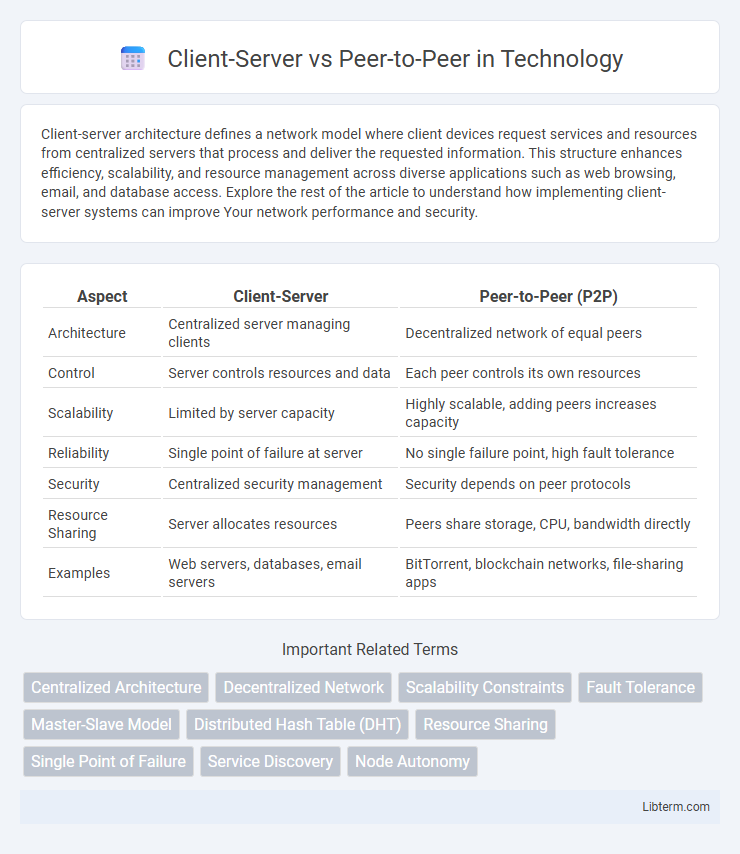Client-server architecture defines a network model where client devices request services and resources from centralized servers that process and deliver the requested information. This structure enhances efficiency, scalability, and resource management across diverse applications such as web browsing, email, and database access. Explore the rest of the article to understand how implementing client-server systems can improve Your network performance and security.
Table of Comparison
| Aspect | Client-Server | Peer-to-Peer (P2P) |
|---|---|---|
| Architecture | Centralized server managing clients | Decentralized network of equal peers |
| Control | Server controls resources and data | Each peer controls its own resources |
| Scalability | Limited by server capacity | Highly scalable, adding peers increases capacity |
| Reliability | Single point of failure at server | No single failure point, high fault tolerance |
| Security | Centralized security management | Security depends on peer protocols |
| Resource Sharing | Server allocates resources | Peers share storage, CPU, bandwidth directly |
| Examples | Web servers, databases, email servers | BitTorrent, blockchain networks, file-sharing apps |
Introduction to Client-Server and Peer-to-Peer Architectures
Client-server architecture relies on centralized servers to provide resources and services to multiple client devices, enabling efficient management and security control. Peer-to-peer (P2P) architecture distributes workloads among connected nodes, allowing each participant to act as both client and server, enhancing scalability and fault tolerance. Understanding these fundamental differences helps in choosing the appropriate network structure for specific applications and usage scenarios.
Core Principles of Client-Server Model
The client-server model operates on a centralized architecture where clients request services and servers provide resources or data, ensuring efficient resource management and security control. Core principles include dedicated servers that handle multiple client requests simultaneously and a clear separation of roles, which allows scalability and easier maintenance. This structure contrasts with peer-to-peer models by prioritizing hierarchical communication and centralized data storage for enhanced reliability and access control.
Fundamentals of Peer-to-Peer Networks
Peer-to-peer (P2P) networks distribute data and resources directly among interconnected nodes without relying on a centralized server, enhancing scalability and resilience. Each peer functions as both a client and a server, enabling decentralized file sharing, communication, and resource allocation across the network. The absence of a single point of failure and dynamic node participation are fundamental characteristics that distinguish P2P from traditional client-server architectures.
Key Differences Between Client-Server and Peer-to-Peer
Client-server architecture centralizes data processing and management on a dedicated server, enabling efficient resource control and security, while peer-to-peer (P2P) distributes workloads across multiple nodes with equal roles, enhancing scalability and fault tolerance. Client-server systems typically offer easier management and robust backup solutions, whereas P2P networks provide decentralized resource sharing and improved network resilience but may face challenges in coordination and security. These fundamental differences influence network design, performance optimization, and application suitability across various computing environments.
Scalability Comparison: Which Model Performs Better?
Peer-to-Peer (P2P) networks generally offer superior scalability compared to Client-Server models due to their decentralized nature, allowing each node to share resources and distribute workloads efficiently. In contrast, Client-Server architectures rely heavily on central servers, which can become bottlenecks as the number of clients increases, limiting scalability and performance. Large-scale applications like blockchain and file sharing predominantly use P2P models to leverage enhanced scalability and fault tolerance.
Security Implications in Both Network Architectures
Client-server architecture centralizes control and data storage on dedicated servers, enabling robust security measures such as centralized authentication, access control, and streamlined monitoring. Peer-to-peer networks distribute data and responsibilities across nodes, increasing vulnerability to unauthorized access and making it challenging to enforce consistent security policies. The decentralized nature of peer-to-peer systems often requires stronger endpoint security and trust management protocols to mitigate risks like data interception and malware propagation.
Typical Use Cases for Client-Server Systems
Client-server systems are commonly used in web hosting, email services, and database management where centralized control enhances security and data integrity. Enterprises rely on client-server architecture for efficient resource allocation and scalability in applications like CRM software and online banking. This model supports real-time data processing and robust access control, making it ideal for corporate networks and cloud-based services.
Real-World Applications of Peer-to-Peer Networks
Peer-to-peer (P2P) networks power decentralized applications such as file sharing platforms like BitTorrent, which enable direct data exchange without centralized servers, reducing bottlenecks and enhancing resilience. Cryptocurrency systems like Bitcoin utilize P2P networks to validate transactions and maintain distributed ledgers securely and transparently. Decentralized communication tools, including certain VoIP and messaging services, rely on P2P architectures to offer fault-tolerant, scalable connectivity without dependence on central infrastructure.
Advantages and Disadvantages of Each Model
Client-server architecture offers centralized control, which enhances security and simplifies data management, but it can suffer from server overload and a single point of failure. Peer-to-peer networks provide improved scalability and resilience by distributing resources across multiple nodes, yet they face challenges with inconsistent data integrity and more complex network management. Each model's suitability depends on the specific application requirements, such as the need for centralized control versus distributed resource sharing.
Choosing the Right Architecture for Your Needs
Selecting the appropriate architecture between client-server and peer-to-peer depends on the scale, control, and resource distribution required by your application. Client-server models excel in centralized management, security, and consistent performance, ideal for business environments with critical data handling. Peer-to-peer networks offer decentralized resource sharing and scalability, making them suitable for collaborative projects or applications with robust fault tolerance needs.
Client-Server Infographic

 libterm.com
libterm.com